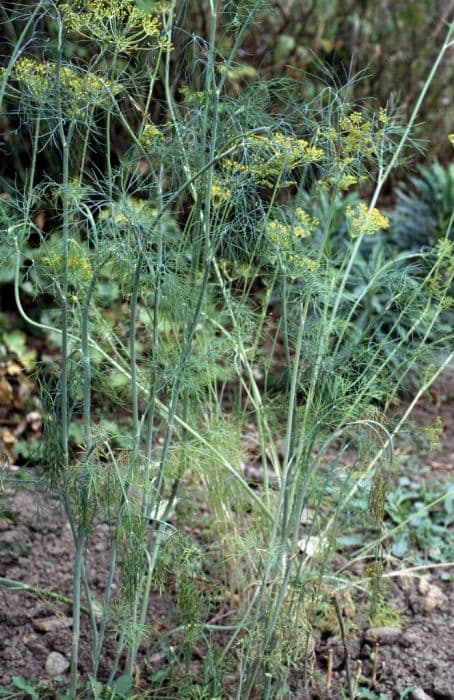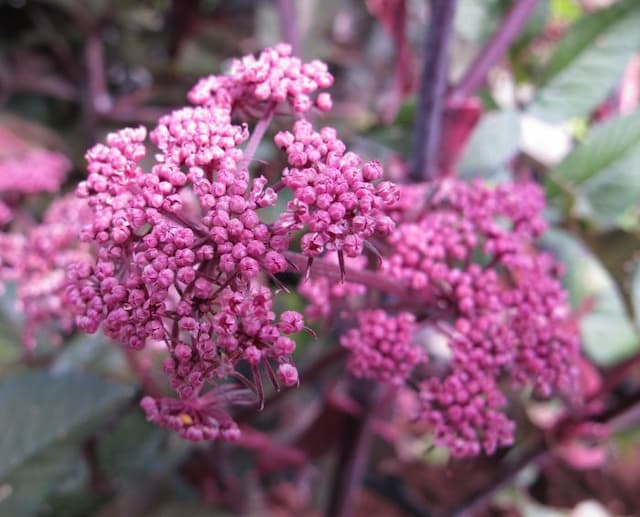Ground elder Aegopodium podagraria

ABOUT
Aegopodium podagraria, commonly known as ground elder, is a perennial plant characterized by its lush, herbaceous appearance. It has bright green, compound leaves that have a serrated edge and are typically divided into groups of three leaflets, with the middle leaflet being the largest. The leaf shape may remind one of an elongated maple leaf. Each leaflet has deeply defined veins that run through its surface, creating texture and giving the plant a vivid, lively look. During the flowering season, ground elder produces small, white flowers that are grouped in flat-topped, umbrella-like clusters known as umbels. These flowers can add to the ornamental value of the plant and can be quite attractive to bees and other pollinators, who are lured in by the fragrance and nectar. The roots of ground elder are rhizomatous, meaning they can spread underground and produce new shoots, enabling the plant to form dense patches which may be considered vigorous or invasive, depending on the context of its growth.
About this plant
 Names
NamesFamily
Apiaceae.
Synonyms
Ground Elder, Bishop's Weed, Goutweed, Snow-in-the-Mountain, English Masterwort, Wild Masterwort.
Common names
Aegopodium alpestre, Aegopodium latifolium, Aegopodium podagraria var. variegatum, Aegopodium tribracteolatum, Aegopodium variegatum, Carum podagraria, Ligusticum podagraria, Podagraria aegopodioides, Podagraria aegopodium, Podagraria major, Sium podagraria.
 Toxicity
ToxicityTo humans
Ground elder (Aegopodium podagraria) is not generally considered toxic to humans. In fact, it is sometimes used as a food plant, where young leaves are eaten as a spring green or vegetable. However, people should be cautious as foraging the wrong plant can lead to unintentional poisoning if a toxic plant is misidentified as ground elder. Always be sure of the exact species before consuming any wild plant.
To pets
Ground elder is not typically listed as a toxic plant to pets. However, as with any non-food plant, consumption in large quantities could potentially cause gastrointestinal upset in some animals due to the novelty and fiber content. If a pet ingests a large amount of ground elder and shows signs of distress such as vomiting or diarrhea, it is advisable to consult a veterinarian. It's important to monitor pets and prevent them from eating large amounts of any non-food plants, as individual sensitivity can vary.
 Characteristics
CharacteristicsLife cycle
Perennials
Foliage type
Deciduous
Color of leaves
Green
Flower color
White
Height
1-3 feet (0.3-0.9 meters)
Spread
1-3 feet (0.3-0.9 meters)
Plant type
Herb
Hardiness zones
4
Native area
Eurasia
Benefits
 General Benefits
General Benefits- Ground cover: Bishop's weed is a robust and fast-growing plant that can cover bare spots in the garden quickly, creating a dense carpet of foliage.
- Erosion control: Its dense growth habit helps stabilize soil and prevent erosion on slopes or in areas susceptible to soil loss.
- Low maintenance: Once established, Bishop's weed requires minimal care, making it an easy plant to maintain for gardeners with limited time.
- Drought tolerance: It is relatively tolerant of dry conditions once established, reducing the need for frequent watering.
- Shade tolerance: Bishop's weed can thrive in shaded areas where many other plants struggle to grow, making it a valuable addition to woodland gardens or shaded borders.
- Edible uses: Some parts of the plant are edible and can be used in salads, soups, and other dishes, although caution is advised as the plant can be invasive.
- Ornamental value: Varieties with variegated leaves add visual interest to the garden with their contrasting patterns and colors.
- Pollinator attractant: The small white flowers of Bishop's weed can attract beneficial insects to the garden, aiding in pollination.
- Culinary garnish: The leaves can be used as a decorative garnish due to their attractive shape and color.
- Companion planting: Its dense growth can help suppress weeds around more valuable plants or in vegetable gardens.
 Medical Properties
Medical Properties- Anti-inflammatory: Aegopodium podagraria (common name: ground elder) has been traditionally used for its anti-inflammatory properties to help reduce swelling and pain, particularly in conditions like arthritis.
- Diuretic: The plant has diuretic effects which can help promote the excretion of urine.
- Antirheumatic: Historically, ground elder has been used to treat rheumatic conditions due to its possible antirheumatic effects.
- Astringent: The astringent properties of the plant may have been used to tighten tissues and relieve irritation.
- Sedative: It has been suggested to have sedative effects, which might help in reducing anxiety and promoting relaxation.
 Air-purifying Qualities
Air-purifying QualitiesThis plant is not specifically known for air purifying qualities.
 Other Uses
Other Uses- Aegopodium podagraria, commonly known as ground elder, has been used as a food dye. The leaves can impart a green hue when used in the culinary arts.
- Ground elder leaves can be used in the preparation of homemade herb-infused vinegars, which add a unique flavor to salad dressings and marinades.
- Its invasive nature has been harnessed in some areas as a means of soil erosion control due to its dense growth habits.
- Some gardeners use ground elder as a form of living mulch to suppress weeds in garden beds, though its aggressiveness should be carefully managed.
- In historical contexts, the plant has been used to polish wooden furniture and floors, where its sap can act as a natural varnish.
- The leaves have been used as an emergency fodder for livestock, particularly when other fodder crops are scarce.
- Ground elder can be used to create a natural green dye for textiles by boiling the leaves to extract color.
- In craftwork, the flexible stems of ground elder have been utilized in weaving baskets and other woven items.
- Young leaves of ground elder can be used to add a decorative element to artisan cheeses and butter.
- Due to its dense foliage, ground elder has been used in theater and film to simulate underbrush or ancient forest ground layers on set.
Interesting Facts
 Feng Shui
Feng ShuiThe Ground Elder is not used in Feng Shui practice.
 Zodiac Sign Compitability
Zodiac Sign CompitabilityThe Ground Elder is not used in astrology practice.
 Plant Symbolism
Plant Symbolism- Invasiveness: Aegopodium podagraria, commonly known as Bishop's Weed, symbolizes tenacity and the ability to thrive in difficult conditions due to its aggressive and invasive growth habit.
- Healing: Historically, Bishop's Weed has been used in herbal medicine to treat gout and arthritis, thus representing healing and relief from pain.
- Protection: In some cultures, it was believed that Bishop's Weed had the ability to ward off evil spirits, symbolizing protection and safety.
- Resilience: Its capacity to survive and quickly recover from adverse conditions makes Bishop's Weed a symbol of resilience and adaptability.
 Water
WaterFor the Ground Elder, proper watering is crucial for maintaining its health. Water the plant deeply once a week, ensuring that the soil is thoroughly moistened. Depending on the weather conditions and soil type, this may require about 1-2 gallons of water per plant. During hot and dry periods, increase watering frequency to twice a week. It's important to avoid overwatering, as Ground Elder does not like to sit in waterlogged soil. Ensure that the plant has well-draining soil to prevent root rot.
 Light
LightGround Elder thrives best in partial shade to full shade conditions. It is well-suited for spots that receive dappled sunlight throughout the day or are fully shaded. Avoid placing it in full sun, as this can cause the leaves to scorch. Ideal locations include under the canopy of larger trees or on the north side of buildings where direct sunlight is limited.
 Temperature
TemperatureGround Elder is a hardy plant that can tolerate a wide range of temperatures, withstanding minimum temperatures down to around -40 degrees Fahrenheit. It grows best in temperatures ranging between 50 and 70 degrees Fahrenheit. Ground Elder may become dormant in extreme heat above 90 degrees Fahrenheit, but it will typically recover when cooler temperatures return.
 Pruning
PruningGround Elder may require pruning to control its spread and to remove any unwanted or dead foliage. Prune it back in early spring or fall to maintain its shape and encourage bushier growth. Since Ground Elder can be invasive, regular pruning may be necessary to prevent it from taking over garden areas. Always trim back to just above a leaf node or a set of leaves to promote healthier regrowth.
 Cleaning
CleaningAs needed
 Soil
SoilGround Elder thrives best in a rich, moist, well-drained soil mix with a slightly acidic to neutral pH of 6.0 to 7.0. To create an optimal blend, mix garden soil with compost and a small amount of sand to improve drainage. If you're planting in a container, use a general-purpose potting mix with some added organic matter.
 Repotting
RepottingGround Elder is a vigorous grower and can spread quickly, but as a hardy perennial mainly grown outdoors, it typically does not require repotting. Instead of repotting, control its spread by dividing the plant every 2-3 years in the early spring or fall.
 Humidity & Misting
Humidity & MistingGround Elder, being a hardy and adaptable plant, does not have strict humidity requirements. It can thrive in the average outdoor humidity levels typical of temperate climates, and no special humidity adjustments are needed for its growth.
 Suitable locations
Suitable locationsIndoor
Place in well-lit area, water regularly, use rich soil.
Outdoor
Plant in shade or part sun, ensure soil is moist.
Hardiness zone
3-9 USDA
 Life cycle
Life cycleAegopodium podagraria, commonly known as ground elder, begins its life cycle as a seed, which upon germination in springtime, develops into a seedling with a notable heart-shaped cotyledon. As the plant grows, it forms a rosette of trifoliate leaves and establishes a robust rhizomatous root system which allows it to spread aggressively. By late spring to early summer, ground elder reaches maturity and produces small, white, umbrella-like flowers in compound umbels which are attractive to pollinators. Following pollination, it sets small, flat, winged fruits called schizocarps that facilitate dispersal by wind. Throughout the growing season, it continues to expand vegetatively, and as a perennial, ground elder dies back to its roots in winter, only to resurface from the rhizomes the following spring. This cycle of vegetative growth and dieback continues annually, contributing to its persistence and invasiveness in environments where it is established.
 Propogation
PropogationPropogation time
Spring-early summer
Propogation: Goutweed, scientifically known as Aegopodium podagraria, is best propagated through division since it spreads vigorously by its rhizomatous root system, making this method both easy and effective. Typically, the best time to divide goutweed is in the early spring or fall when the plant is not actively flowering. To propagate by division, carefully dig up a clump of the plant, making sure to get a good amount of the root system. Then, using a sharp spade or knife, divide the clump into smaller sections, each with several shoots and a portion of the root system. Replant the divisions immediately, watering them well to help establish the newly transplanted sections. This method ensures a quick and reliable way to expand goutweed in the garden or contain its spread when necessary.









